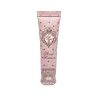What's inside
What's inside
 Key Ingredients
Key Ingredients

 Benefits
Benefits

 Concerns
Concerns

 Ingredients Side-by-side
Ingredients Side-by-side

Hydrogenated Polyisobutene
EmollientHelianthus Annuus Seed Oil
EmollientPhytosteryl/Isostearyl/Cetyl/Stearyl/Behenyl Dimer Dilinoleate
Skin ConditioningDiisostearyl Malate
EmollientCaprylic/Capric Triglyceride
MaskingButyrospermum Parkii Butter
Skin ConditioningHydrogenated Poly(C6-14 Olefin)
EmollientPolyglyceryl-2 Triisostearate
EmulsifyingTocopheryl Acetate
AntioxidantEthylene/Propylene/Styrene Copolymer
Polyethylene
AbrasiveMicrocrystalline Wax
Emulsion StabilisingSilica Dimethyl Silylate
EmollientGlyceryl Caprylate
EmollientSorbitan Sesquioleate
EmulsifyingArgania Spinosa Kernel Oil
EmollientCamellia Japonica Seed Oil
EmollientCamellia Sinensis Seed Oil
HumectantMacadamia Integrifolia Seed Oil
Skin ConditioningOlea Europaea Fruit Oil
MaskingSimmondsia Chinensis Seed Oil
EmollientButylene/Ethylene/Styrene Copolymer
Citrus Junos Seed Extract
AntioxidantLimnanthes Alba Seed Oil
Skin ConditioningMonascus Extract
Skin ConditioningPentaerythrityl Tetra-Di-T-Butyl Hydroxyhydrocinnamate
AntioxidantHydrogenated Polyisobutene, Helianthus Annuus Seed Oil, Phytosteryl/Isostearyl/Cetyl/Stearyl/Behenyl Dimer Dilinoleate, Diisostearyl Malate, Caprylic/Capric Triglyceride, Butyrospermum Parkii Butter, Hydrogenated Poly(C6-14 Olefin), Polyglyceryl-2 Triisostearate, Tocopheryl Acetate, Ethylene/Propylene/Styrene Copolymer, Polyethylene, Microcrystalline Wax, Silica Dimethyl Silylate, Glyceryl Caprylate, Sorbitan Sesquioleate, Argania Spinosa Kernel Oil, Camellia Japonica Seed Oil, Camellia Sinensis Seed Oil, Macadamia Integrifolia Seed Oil, Olea Europaea Fruit Oil, Simmondsia Chinensis Seed Oil, Butylene/Ethylene/Styrene Copolymer, Citrus Junos Seed Extract, Limnanthes Alba Seed Oil, Monascus Extract, Pentaerythrityl Tetra-Di-T-Butyl Hydroxyhydrocinnamate
Polybutene
Hydrogenated Polyisobutene
EmollientPhytosteryl Isostearyl Dimer Dilinoleate
EmollientDiisostearyl Malate
EmollientPhytosteryl/Isostearyl/Cetyl/Stearyl/Behenyl Dimer Dilinoleate
Skin ConditioningDextrin Palmitate
EmulsifyingButyrospermum Parkii Butter
Skin ConditioningMicrocrystalline Wax
Emulsion StabilisingPolyethylene
AbrasiveGlycerin
HumectantBeeswax
Emulsion StabilisingTocopheryl Acetate
AntioxidantEuphorbia Cerifera Cera
AstringentAstrocaryum Murumuru Seed Butter
EmollientEthylene/Propylene/Styrene Copolymer
Triethylhexanoin
MaskingDimethicone
EmollientCaprylic/Capric Triglyceride
MaskingOzokerite
Emulsion StabilisingPolyhydroxystearic Acid
EmulsifyingLimonene
PerfumingPolyglyceryl-2 Dipolyhydroxystearate
Skin ConditioningDisteardimonium Hectorite
StabilisingEthylhexyl Palmitate
EmollientLecithin
EmollientIsostearic Acid
CleansingIsopropyl Palmitate
EmollientSorbitan Isostearate
EmulsifyingParfum
MaskingPolyglyceryl-3 Polyricinoleate
EmulsifyingDehydroacetic Acid
PreservativeButylene/Ethylene/Styrene Copolymer
Linalool
PerfumingTrehalose
HumectantPentaerythrityl Tetra-Di-T-Butyl Hydroxyhydrocinnamate
AntioxidantCitral
PerfumingWater
Skin ConditioningButylene Glycol
HumectantZingiber Officinale Root Extract
MaskingBHT
AntioxidantPolybutene, Hydrogenated Polyisobutene, Phytosteryl Isostearyl Dimer Dilinoleate, Diisostearyl Malate, Phytosteryl/Isostearyl/Cetyl/Stearyl/Behenyl Dimer Dilinoleate, Dextrin Palmitate, Butyrospermum Parkii Butter, Microcrystalline Wax, Polyethylene, Glycerin, Beeswax, Tocopheryl Acetate, Euphorbia Cerifera Cera, Astrocaryum Murumuru Seed Butter, Ethylene/Propylene/Styrene Copolymer, Triethylhexanoin, Dimethicone, Caprylic/Capric Triglyceride, Ozokerite, Polyhydroxystearic Acid, Limonene, Polyglyceryl-2 Dipolyhydroxystearate, Disteardimonium Hectorite, Ethylhexyl Palmitate, Lecithin, Isostearic Acid, Isopropyl Palmitate, Sorbitan Isostearate, Parfum, Polyglyceryl-3 Polyricinoleate, Dehydroacetic Acid, Butylene/Ethylene/Styrene Copolymer, Linalool, Trehalose, Pentaerythrityl Tetra-Di-T-Butyl Hydroxyhydrocinnamate, Citral, Water, Butylene Glycol, Zingiber Officinale Root Extract, BHT
 Reviews
Reviews

Ingredients Explained
These ingredients are found in both products.
Ingredients higher up in an ingredient list are typically present in a larger amount.
We don't have a description for Butylene/Ethylene/Styrene Copolymer yet.
This ingredient is also known as shea butter. It is an effective skin hydrator and emollient.
Emollients help soothe and soften your skin. It does this by creating a protective film on your skin. This barrier helps trap moisture and keeps your skin hydrated. Emollients may be effective at treating dry or itchy skin.
Shea butter is rich in antioxidants. Antioxidants help fight free-radicals, or molecules that may harm the body. It is also full of fatty acids including stearic acid and linoleic acid. These acids help replenish the skin and keep skin moisturized.
While Shea Butter has an SPF rating of about 3-4, it is not a sunscreen replacement.
Shea butter may not be fungal acne safe. We recommend speaking with a professional if you have any concerns.
Learn more about Butyrospermum Parkii ButterThis ingredient is an emollient, solvent, and texture enhancer. It is considered a skin-softener by helping the skin prevent moisture loss.
It helps thicken a product's formula and makes it easier to spread by dissolving clumping compounds.
Caprylic Triglyceride is made by combining glycerin with coconut oil, forming a clear liquid.
While there is an assumption Caprylic Triglyceride can clog pores due to it being derived from coconut oil, there is no research supporting this.
Learn more about Caprylic/Capric TriglycerideDiisostearyl Malate is an emollient and most often used in lip products. It comes from isostearyl alcohol, a fatty acid, and malic acid, an AHA.
As an emollient, Diisostearyl Malate helps create a thin film on your skin to trap moisture in. This helps keep your skin soft and smooth.
We don't have a description for Ethylene/Propylene/Styrene Copolymer yet.
Hydrogenated Polyisobutene is a synthetic polymer. Polymers are compounds with high molecular weight. Hydrogenated Polyisobutene is an emollient and texture enhancer.
In one study, Hydrogenated Polyisobutene showed better skin hydration levels than Caprylic/Capric Triglyceride. As an emollient, it helps keep your skin soft and hydrated by trapping moisture in.
Hydrogenated Polyisobutene is often used as a mineral oil replacement.
Learn more about Hydrogenated PolyisobuteneMicrocrystalline Wax is created by de-oiling petroleum. It is highly refined and purified before being added to cosmetics.
Microcrystalline Wax is used to enhance the texture and create even consistency. It helps stabilize a product by preventing ingredients from separating.
Pentaerythrityl Tetra-Di-T-Butyl Hydroxyhydrocinnamate (long name, huh?) is a synthetic antioxidant.
It is used to help stabilize other antioxidants or prevent the color from changing in a product.
As an antioxidant, it helps fight free-radical molecules. Free-radical molecules are capable of damaging our cells and other genetic material. Thus, antioxidants may reduce the signs of aging.
This ingredient is oil-soluble.
Learn more about Pentaerythrityl Tetra-Di-T-Butyl HydroxyhydrocinnamateWe don't have a description for Phytosteryl/Isostearyl/Cetyl/Stearyl/Behenyl Dimer Dilinoleate yet.
Polyethylene is a synthetic ingredient that helps the skin retain moisture. It is a polymer.
It is also typically used within product formulations to help bind solid ingredients together and thicken oil-based ingredients. When added to balms and emulsions, it helps increase the melting point temperature.
Tocopheryl Acetate is AKA Vitamin E. It is an antioxidant and protects your skin from free radicals. Free radicals damage the skin by breaking down collagen.
One study found using Tocopheryl Acetate with Vitamin C decreased the number of sunburned cells.
Tocopheryl Acetate is commonly found in both skincare and dietary supplements.
Learn more about Tocopheryl Acetate